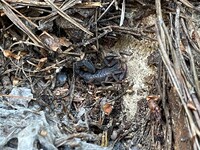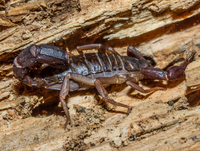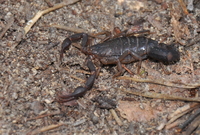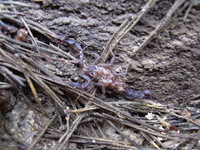Distribution Records
PDF
Vetting Levels |
|
Adult phenology:
High Mountains (HM) ≥ 4,000 ft.
Low Mountains (LM) < 4,000 ft.
Piedmont (Pd)
Coastal Plain (CP)
Click on graph to enlarge
|
 |
|
| synonym | |
| taxonomic_comments |
One of 66 species in this genus, all of which are North or Central American (Sissom, 2000). Carolinianus is the sole species that occurs east of the Mississippi. According to Sissom (2000), this genus is not monophyletic, indicating that several new genera should be eventually described. Sissom includes carolinianus in the Mexicanus Species Group, which includes the type species of this genus (mexicanus) but also appears to be heterogeneous and thus likely to be split and given new genus names. |
| species_comment |
|
| id_comments |
A moderately large scorpion. The dorsal surface of the cephalothorax, abdomen, and tail are dark reddish-brown, with obscure yellowish mottling but no pale stripes. The two species of Centuroides that have been recorded in North Carolina are yellowish to brown, with obvious pale and dark stripes on the dorsal surface (see key in Shelley, 1994). |
| total_length |
4 cm (Ewing, 1929) |
| structural_features |
The telson lacks the tubercle below the sting that is present in the two species of Centuroides (Shelley, 1994). |
| silk_web |
|
| fld_guide_descriptions |
|
| online_photos |
BugGuide |
| prey |
|
| predators |
|
| behavior |
|
| distribution_reference |
The type locality is South Carolina (see Sissom, 2000) and Ewing (1929) gave the range as South Carolina to Texas, excluding North Carolina. Brimley (1938) credits F. Sherman with collecting a specimen at Tryon, which may be the first from this state. No year is given but this may be the same record as listed by Shelley (1994) from Tryon in 1934, but where the collector was apparently not included on the specimen label. |
| technical_reference |
Shelley (1994) |
| adult_id | 1 identifiable by photo 2 identifiable by photo of specific features and/or supplementary info 3 identifiable from specimen only |
| abundance |
Brimley (1938) mentioned that this species is common near Murphy in Cherokee County. In a survey conducted by the Natural Heritage Program along the Cherokee County/Tennessee line (in the Brushy Flats area of the Tusquitee Ranger District), this species was frequently observed under logs. |
| distribution_comments |
The stronghold of this species in North Carolina appears to be the low mountains in the southwest corner of the state. While it may be resident in at least the western Piedmont, records from Wake County in the eastern Piedmont and Columbus County in the southern Coastal Plain may represent artificial introductions (Shelley, 1994). |
checklist_mt_high
>=4,000 ft. | |
checklist_mt_low
<4,000 ft. | |
checklist_pd
Piedmont | |
checklist_cp
Coastal Plain | |
| habitat |
Shelley (1994) stated that he typically finds this species associated with pine logs and stumps. He cites Gibbons as believing that it is restricted to moist woodlands, but specimens observed in Cherokee County by Hall (see Schwartzman et al., 2015) were all found on ridge tops, where they appeared to be fairly common. The habitat in that area was originally dominated by short-leaf and scrub pines but was succeeding to white pines due to fire suppression and attacks on the yellow pines by Southern Pine Beetles. While the habitat did not appear to be exceptionally xeric, neither did it appear to be mesic. This species is occasionally found in buildings where they may have been transported on firewood. |
| observation_methods |
Usually found by turning over logs or stripping off their bark. A less destructive method involves looking for this species at night using a blacklight; as in other scorpions, this species is highly flourescent. This species is capable of producing a painful sting, and should accordingly be collected carefully. However, members of this genus are not believed to be dangerous to humans, at least those that do not have allergic reactions to the venom (the reactions to the venom of this species are apparently unrecorded, Shelley, 1994). |
| state_protection |
Arachnids are not protected under state law, although permits are needed to collect them in State Parks and other public and private nature preserves. |
| NHP_ranks |
G5 S2?->[S3S4] |
| NHP_status |
W2,W3 |
| status_comments |
This species is currently on the Natural Heritage Program Watch List, meaning that more information is needed before its conservation status can be determined. More surveys -- particularly conducted using blackights -- need to be conducted throughout its range in order to determine its distribution, abundance, habitat association, population trends and threats. |
Photo Gallery for Vaejovis carolinianus Southern Unstriped Scorpion |
 | Recorded by: E. Corey, K. Bischof
Transylvania Co.
Comment: GORG - Obs during green salamander survey, along cow trail under rocks and in two circumstances, in cracks of rocks while surveying for green salamanders. |  | Recorded by: Steve Hall
Cherokee Co.
Comment: Several individuals were seen under fallen logs |
 | Recorded by: E. Corey, K. Bischof, D. Brown, S. Becker
Transylvania Co.
Comment: GORG - On Cow Trail, near Foothills Trail, and on the Foothills Trail. |  | Recorded by: Seth Lambiase
Transylvania Co.
Comment: 5 obs. on Cow Trail, 2 in crevices of rock oucrops off FHT. |
|